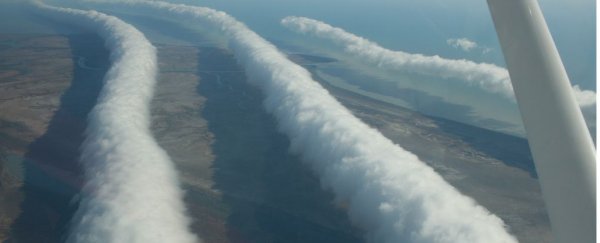But hardly anyone knows about it.
Australia is home to one of the world's rarest meteorological phenomena, which most people have never heard of.
Known as morning glory clouds, these long bands of cigar-shaped formations can stretch up to 1,000 kilometres (621 miles) in length.
And they can only be seen reliably in one place in the world - Australia's Gulf Country township around the Gulf of Carpentaria in northwestern Queensland, each Southern Hemisphere spring (from September to November).
They look like some kind of alien wormhole, but they're definitely a natural phenomenon - although exactly how they form is still unclear.
"What causes these long, strange clouds?" NASA wrote on its APOD site in 2009. "No one is sure."
What we do know so far is the weather conditions that precede them. The iconic roll shape of the cloud is caused by a drop in temperature, a spike in pressure and strong sea breezes.
Because of these conditions, air at the front edge of the cloud is moving up rapidly, while the air at the back is dropping, rolling the cloud into a neat little cylinder.
It's been reported that up to 10 of these clouds can appear across the sky at one time, up to 2 kilometres off the ground.
 (Zeppelie/iStock)
(Zeppelie/iStock)
"Long, horizontal, circulating tubes of air might form when flowing, moist, cooling air encounters an inversion layer, an atmospheric layer where air temperature atypically increases with height," wrote NASA.
"These tubes and surrounding air could cause dangerous turbulence for airplanes when clear."
The morning glory clouds can travel at an incredible speed of 10 to 20 metres per second - that's around 60 kilometres per hour or 37 miles per hour - with new cloud continuously being formed at the leading edge while being eroded from behind.
While scientists still don't fully understand the weather conditions that lead to the clouds, they're associated with humidity in the area and strong sea breezes across the Gulf of Carpenteria, which are the conditions that occur here each spring between late September and early November.
Around the same time, hundreds of hang gliders from around the world flock to the area in the hopes of "surfing" for hundreds of kilometres along the thermals in front of the clouds.
A version of this story was first published in October 2014.
